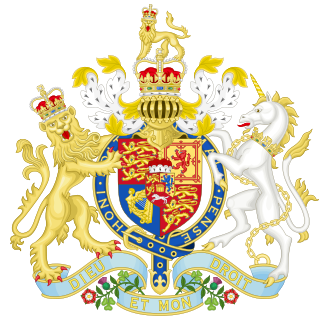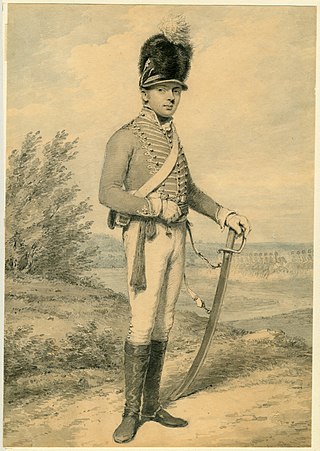Provisions of the Act
The Act brought together a number of the Militia Acts which had been passed during the French Revolutionary Wars (1794-1802), repealing them but broadly re-enacting their content. It provided for an "Old Militia" with a total strength of 51,489 in England and Wales (including the City of London, Cinque Ports, and Stannaries), and allowed for a "Supplementary Militia" of half as many again which could be raised with Parliamentary approval. [2]
Each county's Lord Lieutenant would set the amount of militiamen to be raised from the various areas of their country (for example, dividing it by hundreds), and parish constables would draw up lists of all eligible men between 18 and 45. Men were divided into five classes:
- Under 30, no children
- Over 30, no children
- All men, no living children under 14
- All men, one child under 14
- All other men
Men were to be drawn from the classes in order - if a quota could be filled only from the first and second classes, the third, fourth and fifth were untouched. A class could be taken in its entirety if it was below the absolute quota, but if larger than the number required, a ballot was to be used. Any man who was taken into service through this process was known as a "principal", and was sworn in to serve as a private soldier for a term of five years, after which they were exempt until a fresh ballot was made, or could volunteer for further service. Instead of serving themselves, they could arrange to provide a "personal substitute" who was willing to serve in their stead; this could be a volunteer already on the local ballot, or someone from elsewhere in the county (or a neighbouring county), and it was expected that they would receive a bounty of a few pounds to encourage them to volunteer. Parishes could also arrange to provide parochial substitutes in lieu of their quota of men, and were allowed to levy a parish rate in order to pay bounties to these substitutes. Finally, any balloted man could pay a fine of £10 and avoid service, though he would be liable to be balloted again after five years. The fines were used to hire substitutes and any surplus would go to regimental funds. [2]
A wide range of men were exempt - most obviously, officers and men of the Army, Navy and Marines, but also peers, clergymen, teachers, university students, constables, sailors, apprentices, or men working in royal arsenals or dockyards. A poor man (defined as one with assets of less than £100) with more than one legitimate child was exempt, as was any poor man physically unfit for service, or any man at all less than 5'4" tall. A man worth more than £100 but unfit for service was still liable to pay his fine or provide a substitute. Quakers were not allowed to avoid service through paying a fine, but were required to find a substitute in lieu of service; if they did not do so, the county was empowered to hire one on his behalf and if necessary seize his property to pay for it. [2]
Any men who died or were discharged as unfit would produce a second ballot of the county (in practice, probably of his local parish) to find a replacement. Should the county fail to provide enough men, it would be fined £10 per head of the annual deficit; this money was to be raised locally and could be used to hire substitutes, but if this failed to achieve the desired result, it was paid to the Treasury. [2]

The Militia Act of 1855 was an Act passed by the Parliament of the Province of Canada that permitted the formation of an "Active Militia", which was later subdivided into the Permanent Active Militia and the Non-Permanent Active Militia, and divided the province into 18 military districts.
Bermuda Militia, under Militia Acts 1687–1813. Although the Bermuda Parliament had been formed in 1620, prior to 1687, the Bermudian Militia was raised and organised without reference to a Militia Act. The Crown took over the administration of the Colony from The Somers Isles Company in 1684.
The Militia of Great Britain were the principal military reserve forces of the Kingdom of Great Britain during the 18th century.
The North Devon Militia, later the Devon Artillery Militia, was a part-time military unit in the maritime county of Devonshire in the West of England. The Militia had always been important in the county, which was vulnerable to invasion, and from its formal creation in 1758 the regiment served in home defence in all Britain's major wars until 1909. Having always been an infantry regiment, the North Devon Militia was converted into an artillery unit in 1853, with a role in manning the forts that protected the vital naval base at Plymouth.
The Militia and Volunteers of County Durham are those military units raised in the County independent of the regular Army. The "modern" militia dates from legislation enacted during the Seven Years' War. The volunteers had several forms and separate periods of existence until made a permanent body in 1859.
The Militia and Volunteers of Northumberland are those military units raised in the county independently of the regular Army. The "modern" militia dates from legislation enacted during the Seven Years' War. The volunteers had several forms and separate periods of existence until made a permanent body in 1859.

The Militia (Scotland) Act 1802 was an Act of Parliament of the United Kingdom affecting the Militia, a locally raised force for home defence. It applied to Scotland while there were other acts of the same year applying to England and Wales, and to Ireland.

The Militia (Stannaries) Act 1802 was an Act of Parliament of the United Kingdom affecting the Militia, a locally raised force for home defence. It applied only to the Stannaries of south-western England, and extended the provisions of the main Militia Act 1802 to these jurisdictions.

The Militia (Ireland) Act 1802 was an Act of Parliament of the United Kingdom affecting the Militia, a locally raised force for home defence. It applied only to the Kingdom of Ireland, with the Militia Act 1802 and Militia (Scotland) Act 1802 applying elsewhere in the country.
The Kent Militia Artillery was a part-time reserve unit of Britain's Royal Artillery based at Dover in Kent, from 1853 to 1909.
The Royal Glamorgan Artillery Militia (RGAM) was a part-time reserve unit of Britain's Royal Artillery based at Swansea in Glamorgan, South Wales, from 1854 to 1909.
The Royal Sussex Militia Artillery was a part-time reserve unit of Britain's Royal Artillery from the County of Sussex, which served from 1853 to 1909.

The Provisional Cavalry was a force levied in Great Britain from 1796 for home defence and organised at the county level. The unit was raised by an Act of Parliament instigated by the Secretary of State for War Henry Dundas who thought light cavalry would be particularly effective against any invading force. It was filled by means of an obligation from Britain's horse owners, who had to provide one trooper for every ten horses owned – a method which drew comparisons to the feudal system. Each county had a quota of cavalrymen that it was expected to provide. The act was unpopular and the number and quality of recruits was low.
The Royal Sussex Light Infantry Militia, later the 3rd Battalion, Royal Sussex Regiment, was an auxiliary regiment raised in Sussex on the South Coast of England. From its formal creation in 1778 the regiment served in home defence in all of Britain's major wars. It saw active service during the Second Boer War, and trained thousands of reinforcements during World War I. After a shadowy postwar existence it was formally disbanded in 1953
The South Devon Militia was a part-time military unit in the maritime county of Devonshire in the West of England. The Militia had always been important in the county, which was vulnerable to invasion, and from its formal creation in 1758 the regiment served in home defence in all of Britain's major wars, later as a reserve battalion for the Devonshire Regiment. It was disbanded in 1908.
The Sussex Militia was an auxiliary military force in Sussex on the South Coast of England. From their formal organisation as Trained Bands in 1572 they defended the coastline, watched the Spanish Armada and took an active part in the English Civil War. It was the Sussex Militia who captured the Duke of Monmouth after his unsuccessful Rebellion in 1685. After a long hiatus, the Sussex Militia was reformed in 1778 and provided internal security and home defence in all of Britain's major wars thereafter. It eventually became the Royal Sussex Light Infantry Militia (RSLIM) and also formed the Royal Sussex Militia Artillery. After the Cardwell Reforms the RSLIM became a battalion of the Royal Sussex Regiment and saw active service in the Second Boer War. It served as a Special Reserve training unit in World War I. After 1921 the militia had only a shadowy existence until its final abolition in 1953.
The Gloucestershire Militia was a part-time military force in the county of Gloucestershire in the West of England. From their formal organisation as Trained Bands in 1558 until their final service as a Special Reserve unit of the Gloucestershire Regiment in World War I, the Militia regiments of the county served in home defence in all of Britain's major wars.
The Kent Militia was an auxiliary military force in Kent in the South East England. From their formal organisation as Trained Bands in 1558 until their final service as the Special Reserve, the Militia regiments of the county served in home defence in all of Britain's major wars. They also saw active service during the Second Boer War, and trained thousands of reinforcements during World War I. After a shadowy postwar existence they were formally disbanded in 1953.
The Royal Westminster Militia, later the 5th (Reserve) Battalion, Royal Fusiliers, was an auxiliary regiment raised in the City of Westminster in the suburbs of London. Descended from the Westminster Trained Bands, which were on duty during the Armada campaign of 1588 and saw considerable service during the English Civil War, the regiment underwent reorganisation in 1760 as part of the Middlesex Militia. From 1778 until 1918 the regiment served in home and colonial defence in all of Britain's major wars, and supplied thousands of reinforcements to the Royal Fusiliers during World War I. After a shadowy postwar existence the unit was finally disbanded in 1953.
The Montgomeryshire Militia, later the Royal Montgomeryshire Rifles, was an auxiliary regiment reorganised in the Welsh county of Montgomeryshire during the 18th Century from earlier precursor units. Primarily intended for home defence, it served in Great Britain and Ireland during Britain's major wars. It later became part of the South Wales Borderers until it was disbanded in 1908.



